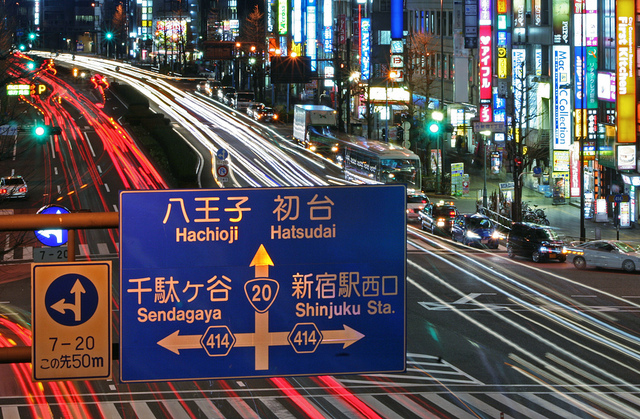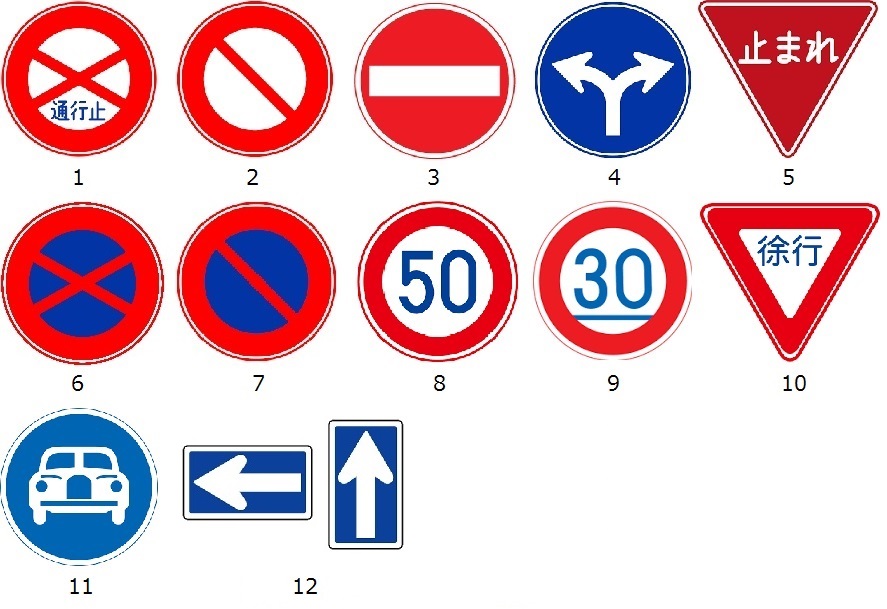
photo by tokyoform
Air flights, trains and buses, there are so many public transports in Japan. But if you are with a group of your friends, traveling by car can be the handiest transport method. One thing that may concern you is the traffic regulations in Japan. Not just in Japan, it is best to know local traffic law when you drive any foreign country unfamiliar to you. This column will introduce road sign meanings and driving tips that you should know before driving in Japan.
Basics to drive in Japan
Japan is one of a few countries of left-hand traffic. Cars are generally right hand drive unless imported from right-hand traffic countries. Roads are well maintained throughout the country and you can enjoy pleasant driving on both general roads and express ways. To drive in Japan, you must have a Japanese driver license. You must be at least 18 years of age to apply for a driver license in Japan. If you are a non-Japanese national, you can drive in Japan with an International Driving Permit approved under Japanese law instead of obtaining a Japanese driver license. Also, driver licenses of certain countries are valid in Japan if an approved Japanese translation is attached.
Among all road signs exist all over Japan, most of guide signs showing directions and name of places are written in Japanese and English while regulatory signs and indication signs are only in Japanese.
In Japan, all driver and passengers must wear safety belts while travelling. All children aged under six must be secured in an approved child restraint when travelling. Children aged six years or above and 140cm or shorter are expected to sit on a booster seat while travelling in cars.
Road signs
As previously mentioned, many of road signs in Japan are only written in Japanese except for name of places and facilities on guide signs. It is crucial to learn road sign meanings to drive in Japan safely. The following are common road signs on general roads in Japan.
Guide signs

Firstly, guide signs that indicate directions, distances, name of places and type of roads. The background color of general roads guide signs is blue. There are a few types of guide sign: signs for directions and distances set up before junctions, and signs set up after junctions that indicate name of streets, type of national/prefectural roads, name of places and other information.
Regulatory signs
Other than guide signs, there are many regulatory signs on general roads of Japan. The purpose of these regulatory signs is to protect the road safety. Among a large number of signs, the following regulatory signs are especially important.

- Closed to vehicles & pedestrians: No vehicles and pedestrians are allowed to enter
- Closed to all vehicles: No vehicles including light vehicles are allowed to enter
- Do not enter: Often placed at one end of a one-way street. No entry allowed from this end
- Direction indicator: Vehicles are allowed to proceed in indicated directions only
- Stop: Vehicles must come to a complete stop
- No parking or stopping anytime
- No parking
- Maximum speed
- Minimum speed
- Slow: Drive at a speed you can immediately stop
- Motor vehicles only: No pedestrians, light vehicles such as motorbikes under 125cc
- One way
Things to know before driving in Japan
Stop before crossing train tracks
This rule seems to be uncommon in overseas. But under Japanese law, you must stop before you cross train stacks even though a crossing gate is open. Many of Japanese cities have developed advanced train networks, thus there are countless number of railroad crossings. To avoid serious situations, for example you fail to cross the track before safety gate closes and your car is shut in the crossing, it is important to follow this rule.
Why everyone is speeding?
The speed limit on general city roads is normally 40kph, 20-30kph on sideways, 80-100pkm on expressways and 50-60pkm elsewhere. This probably is a little lower than your country. Unfortunately, you will notice once you start driving in Japan that, no one else is obeying the speed limit. This may be because the there is only a limited number of speed cameras on streets. Anyway, make sure not to drive over limit as Japanese police is regularly monitoring traffic offences.
Watch out for red light runners
Again it is commonly seen in Japanese cities. There are so many traffic lights! Also, you hardly see roundabouts which are very common in overseas countries. This may be one of the reason that so many traffic light exist. Then, rushing into a junction when the light is turning red is very common practice in Japan. Therefore you should be very careful with such cars driving through on red light. Also, never try to rush on yellow light even though the annoyance of frequently stopping at traffic lights is very natural and understandable.
Flashing hazard lights means “Thank you”
Probably you have seen a car flashing hazard lights a few times when you let it change lanes in front of you. Flashing hazard lights is a common way to appreciate the driver of the car behind for giving way, and not a sign for an emergency.
Happy driving!
Yes, there is a difference in directions of traffic, left or right. Other than that, Japanese traffic rules are not very different from other countries. However, many of road sign designs, especially regulatory signs, are only used in Japan, therefore it is important to learn about Japanese traffic signs beforehand. There are many more traffic signs other than signs introduced in this column. If you are going to drive in Japan, here is a useful list of Japanese traffic signs. Most of drivers in Japan drive in a good manner, though, you may encounter a rough driving occasionally. So, drive safely.
Related Article:
Three options for foreigners to drive a motor vehicle in Japan
Check before driving! Traffic offences in Japan
Driver license: Procedures to update residential address when moving house
Driving tips in Japan: Gas Stations
Driving tips in Japan: Car parks
Driving tips in Japan: Toll roads
Driving tips in Japan: Car accident
Driving tips in Japan: Traffic ticket
Unlimited use of expressways! Japan Expressway Pass for foreign tourists
Touring Japan by car: Rental-car guide for tourists
Best for driving trip! Regional expressway passes
Stuck on the road? Call JAF for roadside assistance
If you are buying a car in Japan: Guide to Japanese car insurance
What are insured? Check this before hiring a car in Japan
Japanese people no longer into owning cars? Car sharing in Japan
BRRR-lliant holiday in Japan! Rental motor bike
Comfortable camping in winter! Renting campervan in Japan
Get first driver license in Japan! Driving lessons in English
Selling a car? Get your car transported
